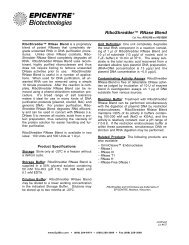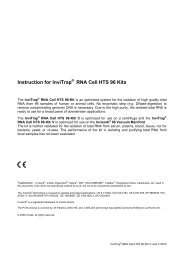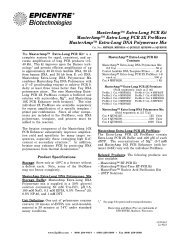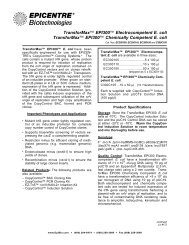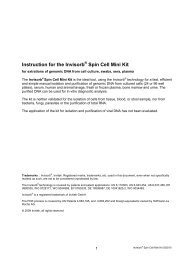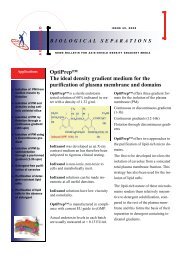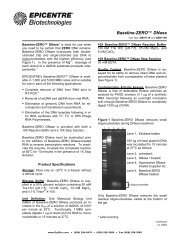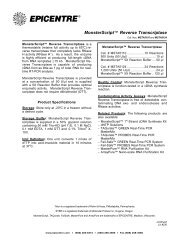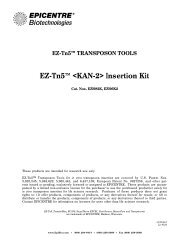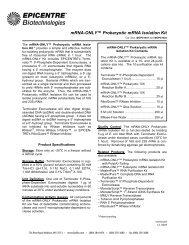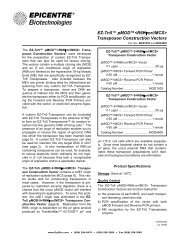Iodinated density gradient media
Iodinated density gradient media
Iodinated density gradient media
- No tags were found...
You also want an ePaper? Increase the reach of your titles
YUMPU automatically turns print PDFs into web optimized ePapers that Google loves.
Some elders in Deline and Colville Lake have noted that the thickness of lake ice hasgone from 8’ to 5’ on Great Bear Lake and 6’ to 4’ on Colville Lake. They should know,as they are people who depend heavily on fish in summer and winter.Beginning in the late 70’s, there has been the build-up of more and more frost on thewillows and trees in the winter time. This used to happen in the fall, but after a periodof time with wind all this frost used to disappear. With the quicker and unpredictablechange between warm and cold weather in the winter, brought about by climatechange, this (frost build-up) has been occurring regularly since the late 70’s, in winter.The frost becomes so thick that the wind doesn’t blow it off. This affects small winterbirds and grouse that depend on the trees for food. The frost was not hard to notice,because, when we travel by snowmobile, on seismic lines where short willows grow andwhen you drive over these willows, the frost falls on the hood and windshield and intothe engine where it melted and caused steam. The steam, soaks into your mitts andparka, making it necessary to stop more often to make fire to dry out.There is a section up the Hare Indian River, above Neraten (winter road crossing),where a whole bunch of big trees have uprooted. It looks like what happened is that, asthe permafrost melted underneath, there was less stability for the larger trees and amoderately strong wind was able to knock them all down.P.43 Barrenland Caribou – according to GNWT (ENR), the population of the BluenoseWest Herd, which populates the Colville Lake/FGH areas, was at around 100,000 in1988 and then 20,000 in 2005. Is this worth mentioning as a value and as a reason forcertain conformity requirements in the plan? I think that it is – if not, we may findourselves without that herd in the not too distant future.P.70 My preference is to include subsurface protection for protected areas.P.76 VisionI prefer more conservation, as opposed to economic development, and to keep more ofthe SSA in the state it has always existed.P.82 Would prefer “conditions” to the word “terms”.P.84 Map 16 Land Use ZonesI note that a large portion of the GUZ total in the plan is north of FGH and around theColville Lake area. I have a concern about this because this area is the winter range ofthe Bluenose West Herd, a herd which is already in decline. In the future, there will bePage 3 of 6
A number of lines of evidence point to the lower toxic-Web:www.axis-shield-<strong>density</strong>-<strong>gradient</strong><strong>media</strong>.comAXIS-SHIELDPO Box 6863 RodelokkaN-0504 OsloNorwayPhone: +47 24 05 60 00Fax: +47 24 05 60 10Email: bjh@no.axis-shield.com orjohn@jgrescon.fsbusiness.co.ukosmolality. However when OptiPrep is diluted withan isoosmotic medium to provide a solution containing40- 50% (w/v) iodixanol, the osmolality is easily measuredand reproducible and in the range 285-305 mOsm.In this manner working solutions can be producedwhich are iso-osmotic with the biological particles beingfractionated. See “Preparation of <strong>gradient</strong> solutions”for more details.Solutions of Nycodenz®‚ are less viscous (see viscosityfigure) than any other <strong>gradient</strong> medium, except CsCl,thus particles sediment very rapidly in this medium.When very dense <strong>gradient</strong>s are required, the viscositycan be reduced even further by using deuterium oxide(D 2 O) as the <strong>gradient</strong> solvent (ρ = 1.105 g/ml). However,partial substitution of D 2 O for H 2 O in the hydrationshell of particles is likely to lead to an increase intheir effective buoyant densities.Although the viscosity of iodixanol solutions is slightlyhigher than those of Nycodenz®, it is lower than thoseof sucrose. Since however many particles exhibit densitiesin iodixanol that are much lower than those in sucrose(and often lower than those in Nycodenz®), the<strong>density</strong> range of <strong>gradient</strong>s of iodixanol required to bandthe particles is also lower. Consequently these <strong>gradient</strong>susually have a very low viscosity.Biological propertiesity of Nycodenz® and iodixanol compared to all other<strong>gradient</strong> <strong>media</strong>. Both Nycodenz® and iodixanol, aswidely used X-ray contrast <strong>media</strong> (Omnipaque andVisipaque respectively), have undergone extensiveclinical testing. Comparative clinical studies with otherX-ray contrast <strong>media</strong> have shown the non-toxic natureof Nycodenz®. In clinical trials iodixanol has beenshown to have extremely low acute toxicity in rodentsand the LD 50 was higher than for any other X-ray contrastmedium tested. Upon injection it is rapidly excretedby the kidneys in an unchanged form and in clinicaltrials iodixanol showed a lower frequency of adverseeffects, compared to other <strong>media</strong>.Studies have shown that iodixanol does not bind to proteinsin human plasma and neither iodixanol or Nycodenz®have significant effects on cell morphology oron cell growth, nor are they metabolized by cells.MOLT-4 T cells have been grown as monolayers in astandard RPMI medium supplemented with 5% (w/v)iodixanol. After 1-72 h the increase in viable cell number,as judged by the MTT Test was identical to controlcells grown in the absence of the medium. Confluentmonolayers of human embryo lung fibroblasts can beexposed to 30% (w/v) iodixanol in culture medium forup to 3 days without any change in cell viability or subsequentplating efficiency. Nycodenz® solutions havealso been shown to be very resistant to bacterial degradation.References are available on request. More informationcan be found at: www.axis-shield-<strong>density</strong><strong>gradient</strong>-<strong>media</strong>.comFicoll and Percoll are trademarks of GE Healthcare




